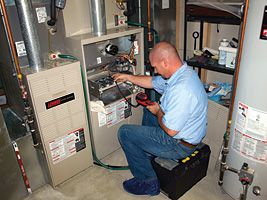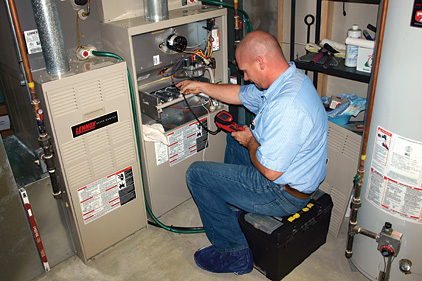
|
| For contractors, making the decision to switch what equipment brand they offer is a big one. Those who have done it say to make sure the local rep is at the top of its game, or the relationship could be a rocky one. |
Choosing which equipment brand to sell is a chief decision contractors make when running an HVAC company.
While some contractors switch equipment lines on a whim, others do so out of necessity. Some contractors remain faithful to one brand their entire careers, and others are finding success juggling equipment lines.
Cost Considerations
Adam Gloss, former vice president, Bel-Red Energy Solutions, Mukilteo, Washington, and current general manager, Johnson Controls/York UPG, said at Bel Red, he kept his primary brand intact for a long period of time, but, over the last several years, changed up his secondary offerings a few times. Gloss said such a drastic change occurs when an issue arises that cannot be rectified. In his experience, this move has never occurred on a whim.
“It actually created a significant expense and short-term drag on our company every time we switched brands, so we didn’t do it without a compelling reason,” Gloss said. “That being said, as market conditions and product lines change, or fail to keep up with change, there are reasons to change, and advantages do come with those changes. These can include application advantages, pricing or profit advantages, etc.”
Loyalty Royalties
Matt Marsiglio, operations manager, Flame Heating, Cooling & Electrical, Warren, Michigan, said his company has featured one primary brand during his 17-year tenure with the company. This, he said, is a benefit because it builds consumer confidence, helps form a quality relationship with the supplier, and equips the team with superior equipment familiarity.
“We believe it is the product our customers deserve,” Marsiglio said. “We’ve been with them through good times and bad times, and it’s more of a team, I’d say. I think it says more to the end user when we can say we’ve been with them that long. It builds confidence with the consumer that we’re not selling junk.”
The Unbranded Approach
Steve Moon, president, Moon Air Inc., Elkton, Maryland, said relationships with manufacturers typically go sour in one of two ways — either they let you down, or you get in so deep that you can’t pay your bill and they cut you off.
“For us, they let us down,” Moon said. “When we needed supply, they simply wouldn’t give us that supply. Time after time, they just didn’t seem to have what we needed in stock. They needed to keep what they had for their larger dealers. So I had to make a decision.
“I switched manufacturers and, once again, they let me down. It wasn’t their fault, but it was their rep’s fault. He made a bad decision on a warranty call I had. So, after that, I said screw this brand thing and decided not to associate myself with brands anymore. I decided to sell myself and pick the best brand I could find for the job and make that the primary brand I sell. On my trucks and in my advertising, you don’t see any specific brand anymore.”
When Should I Switch?
Is switching manufacturers something your business is considering? There are many things you must consider before — and after — pulling the trigger. “When you switch, there’s a huge learning curve and whole lot of pain for the contractor,” Moon said. “If you don’t have a really strong sales rep to help you through that process, it’s misery, and that’s why most stay.”
That learning curve also is a concern for Gloss. He said Bel Red works with its representative manufacturer and distributor to provide more than 100 hours of in-depth training to its installers, technicians, and sales staff when the company starts a new product line — and that training continues as everyone learns the intricacies of the new line.
“We believe the manufacturer should provide us with high-quality, reliable products to sell and install that fit the applications we work with and meet the needs and wants of our customers at a price that allows us to be competitive and profitable,” Gloss said. “We also rely on them for training and technical support.
“Secondary to that is assistance with marketing and/or incentive programs. We do most of this on our own, so we are really looking for a manufacturer that gives us the flexibility to do this. That is what matters to us. Other contractors need to understand their own priorities and find the right manufacturer based on what is important to them.”
Those considerations are critical when finding the right pairing, Moon said. He noted, in today’s world, it’s all about who is going to offer you the best deal.
“A lot of manufacturers offer financing the average contractor can’t put together on his own,” Moon said. “That’s a real good reason to align yourself with a manufacturer, because that company will help you close sales. Manufacturers, as a whole, have become very wise the last five years and instead of trying to educate you on how to sell the product, they want to educate you on how to run your business and be more profitable. That’s how they build their loyalty.”
Even though Marsiglio’s company hasn’t switched manufacturers in his time with the company, he said it’s oftentimes a bad idea to offer equipment from a couple of different brands. For contractors who do switch, he said, it is usually all about the almighty dollar, as a company might get a better deal or more marketing funds, among other things.
“I don’t hold anything against [those who switch],” Marsiglio said. “I think there are two trains of thought. There’s ours, where we want to offer one product and build confidence with customers, and there’s another who feels they can offer the consumer whatever they want. I’m not sure one way is better than the other. Because we service any make and model, we have relationships with others, so we get calls from time to time, and I’d be lying if I said we weren’t close to making the swap, but there’s so many things that go into changing.”
Moon said his company’s benefited from offering an array of equipment options because today’s HVAC customer is more savvy than ever before.
If you are preparing to make the swap, Moon advised to start and end the process with the local rep. He added, that could be the person who will make or break this relationship.
“The first thing they should do, in my mind, is to really get to know their local rep for that piece of equipment,” Moon said. “Check him out, because he’s the guy that is going to make or break this experience. Ask for names of other contractors they’ve recently converted. Be the customer. Go to those contractors and ask for their experience. I literally go to other people’s shops and ask around. … They’re your partners. They have to be on your team and have your best interest at heart.”
Publication date: 6/9/2014
Want more HVAC industry news and information? Join The NEWS on Facebook, Twitter, and LinkedIn today!



Report Abusive Comment